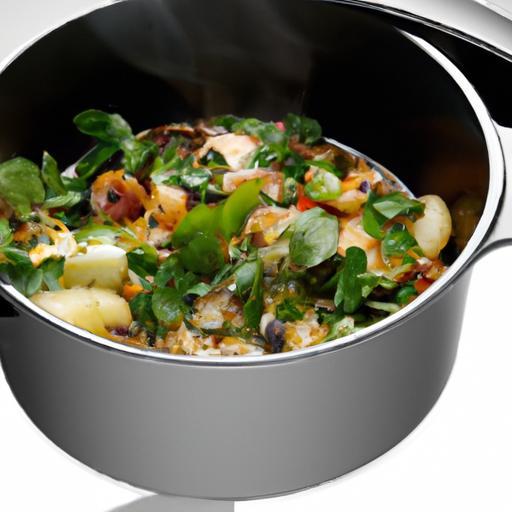In the world of culinary artistry and delicate craft, precision is key-and sometimes, that precision comes from a humble yet ingenious tool: the double boiler. Often whispered about in kitchens as the secret to creamy chocolate, velvety custards, and perfectly melted butter, the double boiler, or bain-marie, is more than just a household gadget. It’s a time-tested method that unlocks the magic of gentle, even heat, transforming recipes that demand patience and care. Join us as we unravel the science, history, and practical wonder behind the bain-marie, revealing how this simple technique elevates cooking from ordinary to extraordinary.
Mastering Temperature Control Techniques for Perfect Melting and Cooking Results
Unlocking the Magic of Double Boilers: The Bain-Marie Explained is the secret behind many culinary masterpieces that require gentle, even heat. This process preserves the delicate flavors and textures that can be easily compromised by direct heat. The double boiler’s layered heating method ensures slow, controlled melting-transforming ingredients like chocolate, butter, and custards into silky, luxurious components without scorching or seizing.
Imagine melting rich 70% dark chocolate for ganache or preparing a creamy hollandaise sauce without any risk of curdling. The steam from simmering water heats the upper bowl just enough to melt or warm without ever crossing the boiling point directly. If you’ve ever wrestled with burnt chocolate or curdled sauces, you’ll appreciate how this humble kitchen tool turns frustration into success.
Prep and Cook Time
- Preparation: 5 minutes
- Cooking/Melting: 10-20 minutes
Yield
- Serves 4-6 (varies by recipe)
Difficulty Level
- Easy to Medium
Ingredients for Classic Double Boiler Chocolate Ganache
- 8 oz high-quality dark chocolate, chopped
- 1 cup heavy cream
- 1 tbsp unsalted butter, room temperature
- Pinch of fine sea salt (optional)
Instructions
- Fill the bottom pot of your double boiler with about 2 inches of water. Bring it to a gentle simmer over medium-low heat. Avoid boiling to prevent steam splashes.
- Place the chopped dark chocolate in the upper bowl or heatproof mixing bowl that fits snugly over the water pot. Ensure the bottom of the upper bowl does not touch the water.
- Pour the heavy cream slowly into the chocolate and stir gently with a silicone spatula. Continue stirring until the chocolate melts and cream blends into a smooth, glossy ganache-approximately 10 minutes.
- Add the unsalted butter and a pinch of sea salt to enhance richness and balance. Stir until combined and silky.
- Remove the bowl from heat immediately to prevent overheating. Use the ganache to glaze cakes, fill truffles, or drizzle over desserts.
Chef’s Notes
- Temperature control is paramount-keep water simmering, not boiling, to avoid sudden temperature spikes.
- For precision melting, use a thermometer to maintain temperatures around 110°F (43°C).
- Try substituting heavy cream with coconut cream for a dairy-free alternative; the double boiler preserves its smooth texture beautifully.
- Leftover ganache can be refrigerated in an airtight container and gently reheated using the same method.
- If you don’t have a double boiler, place a heatproof bowl over a saucepan filled with simmering water to mimic the effect, making sure the bowl doesn’t touch the water.
Serving Suggestions
Serve your ganache as a decadent sauce over fresh berries, or let it cool and whip slightly for a luscious mousse. For an elegant finish, sprinkle with edible gold dust or fresh mint leaves, adding vibrant color and freshness that complement the smooth, glossy finish. This gentle melting technique ensures every bite melts effortlessly on your tongue, impressing guests with both texture and depth of flavor.

Nutrition Information (per serving)
| Calories | Protein | Carbs | Fat |
|---|---|---|---|
| 250 kcal | 3 g | 18 g | 20 g |
Discover more tips on temperature control in kitchen techniques by visiting our Temperature Control Guide and dive deeper into how gentle heating can elevate your cooking. For a rich understanding of bain-marie history and applications, check this detailed article from Britannica.
Q&A
Q&A: Unlocking the Magic of Double Boilers – The Bain-Marie Explained
Q1: What exactly is a double boiler, or Bain-Marie, and why does it have such a magical reputation in cooking?
A1: Think of a double boiler as a gentle, soothing bath for your delicate ingredients. It’s a kitchen tool consisting of two stacked pots-one sitting above the other-where the bottom pot holds simmering water that heats the upper pot indirectly. This slow, even warmth unlocks culinary magic by preventing scorching or curdling, perfect for melting chocolate, crafting silky custards, or making luscious hollandaise. Its gentle approach transforms temperamental ingredients into velvety masterpieces.
Q2: How does the Bain-Marie differ from direct heat cooking?
A2: Imagine cooking over a whisper instead of a shout. Direct heat applies relentless, concentrated energy that can easily scorch or scramble sensitive foods. The Bain-Marie, by contrast, envelops its contents in mild, moist heat from the steam and simmering water below, creating a controlled environment that cooks slowly and evenly. This enchanting method preserves texture, flavor, and integrity, turning what could be a culinary disaster into a triumphant delight.
Q3: Can I make a Bain-Marie at home without special equipment?
A3: Absolutely! No need for a fancy bargain at the kitchen boutique. All you need is a heatproof bowl or smaller pot that snugly fits over a larger pot filled with simmering water. Just ensure the water doesn’t touch the bottom of the upper vessel. This DIY double boiler setup invites you to experiment and bring the Bain-Marie’s magic right to your own stove, making gourmet techniques approachable for any home chef.
Q4: What are some classic dishes that rely on the Bain-Marie’s gentle touch?
A4: The Bain-Marie is the unsung hero behind many culinary icons. From melting smooth chocolate for ganaches and truffles to gently cooking eggs into velvety custards like crème brûlée, it’s central to creating silky sauces such as hollandaise and béarnaise. Beyond sweets, it’s perfect for warming delicate soups or slow-cooking savory terrines, making it versatile magic for both sweet and savory artistry.
Q5: Are there any tips to master the Bain-Marie technique like a kitchen wizard?
A5: First, patience is your ally-slow and steady wins the race! Keep the water at a gentle simmer, never a rolling boil, to avoid overheating. Ensure your upper pot or bowl is dry on the outside to prevent extra water from dripping in. Stir frequently for even heat distribution, especially with chocolate or custards. Lastly, always use quality, heatproof vessels to ensure safety and performance. Master these rituals, and the Bain-Marie becomes your trusted spellbook for culinary enchantment.
Unlocking the Bain-Marie’s secrets reveals a world where subtlety reigns supreme, and precision meets artistry. With this simple yet ingenious method, you can elevate everyday cooking into magical creations worthy of any feast.
In Conclusion
As the gentle steam rises and warmth envelops your carefully balanced vessel, the double boiler-or bain-marie-reveals itself as more than just a kitchen tool. It’s an age-old secret, a silent guardian of delicate flavors and textures, patiently coaxing ingredients to perfection without the fear of scorching or curdling. Whether you’re tempering chocolate, crafting velvety custards, or melting butter with tender care, understanding the magic behind this humble apparatus unlocks a world of culinary possibilities. Embrace the bain-marie, and let your cooking flow with the grace of steam, balancing science and artistry in every simmering moment.


